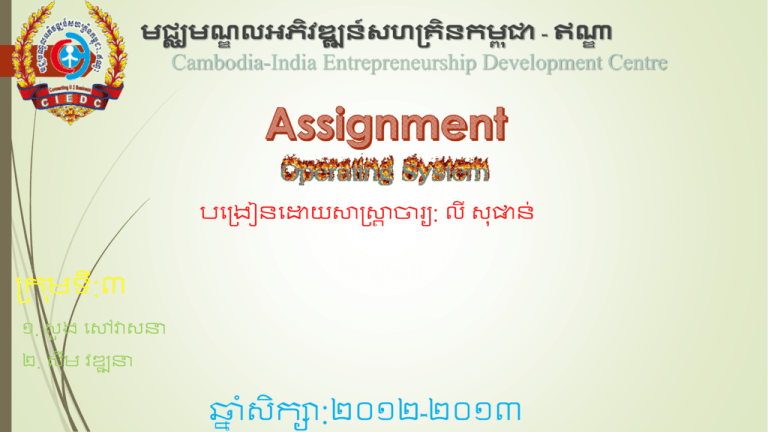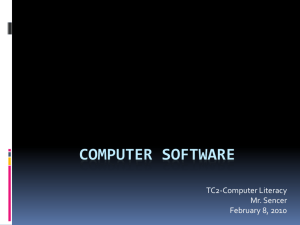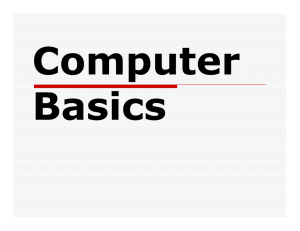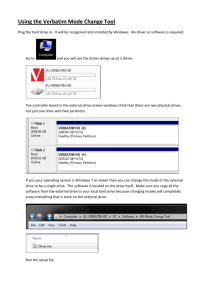How we interact with our computer, and what application it can run
advertisement

មជ្ឈមណ្ឌលអភិវឌ្ឍន៍សហគ្រិនកមពុជា - ឥណា្ ឌ Cambodia-India Entrepreneurship Development Centre បង្រៀនងោយសាស្រ្សាាចារ្យ: លី សុផាន់ ្រ ុមទី:៣ ១. សួ រ ងៅវាសនា ២. សឹម វឌ្ឍនា ឆ្នាំសិរា:២០១២-២០១៣ How we interact with our computer, and what application it can run affects our ability to communicate with others. Computer operating systems enable us to use application software, store information, and join the network. The operating system is the most important program running on a computer, without it the other programs and features do not operate. In this chapter you will learn about the most popul operation system , and How to choose the one that will be right for your computer. After computer of this chapter, you should be able to: Describe the purpose of an OS and identify common operating system available. Perform an actual or simulated installation of an operating system and prepare the computer to participate on the network. Maintain the operating system. System components and peripherals, by themselves, are nothing more than a collection of electronics and mechanical parts. To get these parts to work together to perform a specific task, a special type of computer program, known as an operating system (OS), is required. Suppose that a user wants to write a report and print it out on an attached printer. A word processing application is required to accomplish this task. Information is entered from the keyboard, displayed on the monitor, saved on the disk drive and then finally sent to the printer. In order for the word processing program to accomplish all of this, it must work with the OS, which controls input and output functions. In addition, the entered data is manipulated inside of the computer, stored in RAM and processed by the CPU. This internal manipulation and processing is also controlled by the OS. All computerized devices, such as servers, desktops, laptops or handhelds, require an OS in order to function. The OS acts like a translator between user applications and the hardware. A user interacts with the computer system through an application, such as a word processor, spreadsheet, computer game or instant messaging program. Application programs are designed for a specific purpose, such as word processing, and know nothing of the underlying electronics. For example, the application is not concerned with how information is entered into the application from the keyboard. The operating system is responsible for the communication between the application and the hardware. When a computer is powered on, it loads the OS, normally from a disk drive, into RAM. The portion of the OS code that interacts directly with the computer hardware is known as the kernel. The portion that interfaces with the applications and user, is known as the shell. The user can interact with the shell using either the command line interface (CLI) or graphical user interface (GUI). When using the CLI, the user interacts directly with the system in a text-based environment by entering commands on the keyboard at a command prompt. The system executes the command, often providing textual output. The GUI interface allows the user to interact with the system in an environment that uses graphical images, multimedia, and text. Actions are performed by interacting with the images on screen. GUI is more user friendly and requires less knowledge than CLI of the command structure to utilize the system. For this reason, many individuals rely on the GUI environments. Most operating systems offer both GUI and CLI. Operating systems have complete control of local hardware resources. They are designed to work with one user at a time. They enable the user to multitask. The operating system keeps track of which resources are used by which application. In order to work with resources that are not directly connected to the computer system, a special piece of software must be added that allows a device to send and receive data from the network. This software, known as a redirector, may either be an integral part of the OS or may need to be installed separately as a network client. When installed, the operating system becomes a network operating system (NOS). A NOS offers complex scheduling and user management software that allow a device to share resources between many users and treat networked resources as though they are directly connected. An OS is installed in a defined section of the hard disk, called a disk partition. There are various methods for installing an OS. The method selected for installation is based on the system hardware, the OS being installed, and user requirements. There are four basic options available for the installation of a new OS: Clean Install A clean install is done on a new system or in cases where no upgrade path exists between the current OS and the one being installed. It deletes all data on the partition where the OS is installed and requires application software to be reinstalled. A new computer system requires a clean install. A clean install is also performed when the existing OS installation has become damaged in some way. Upgrade If staying within the same OS platform, it is often possible to do an upgrade. With an upgrade, system configuration settings, applications and data are preserved. It simply replaces the old OS files with the new OS files. Multi-boot It is possible to install more than one OS on a computer to create a multi-boot system. Each OS is contained within its own partition and can have its own files and configuration settings. On start-up, the user is presented with a menu to select the desired OS. Only one OS can run at a time and it has full control of the hardware. Virtualization Virtualization is a technique that is often deployed on servers. It enables multiple copies of an OS to be run on a single set of hardware, thus creating many virtual machines. Each virtual machine can be treated as a separate computer. This enables a single physical resource to appear to function as multiple logical resources. Once an operating system (OS) or application is installed, it is important to keep it up to date with the latest patches. A patch is a piece of program code that can correct a problem or enhance the functionality of an application program or OS. They are usually provided by the manufacturer to repair a known vulnerability or reported problem. Computers should be continually updated with the latest patches unless there is a good reason not to do so. Sometimes patches may negatively impact the operation of another system feature. The impact of the patch should be clearly understood before it is applied. This information can usually be found on the software manufacturer's web site. An operating system, OS, is the most important software in a PC. It is responsible for making all of the component and software application work together. The kernel interacts directly with the hardware; the shell interacts with the applications and the user. the user interacts with the shell through the command line interface or a graphical user interface. A NOS allows a device to share resources among many users and treat networked resources as though they are directly connected. the software that enables the NOS to send and receive data from the network is called a redirector. Perform a pre-installation checklist before installing any new OS. An OS is installed a disk partition, which is a defined section of the hard disk. Decide on partition schemes before installing the OS. To participation in a network, computer requires a network. interface card (NIC) Configured with an IP address, Subnet mask and default gateway. A network should be well planned, logically organized and well documented. An OS and application software must be kept up to date with the latest revisions, upgrades, or patches. A patch is a piece of program code that corrects a problem or enhances the functionality of an OS. An OS can be configured to connect automatically to the manufactures' web site, download and install minor updates without any user intervention. Service packs are major updates to an OS or software application. Application software can also require patches and updates to repair a detected vulnerability in the application. Applications patches are generally found through the manufacturer's website. Thank you for your attendant Good Luck !





